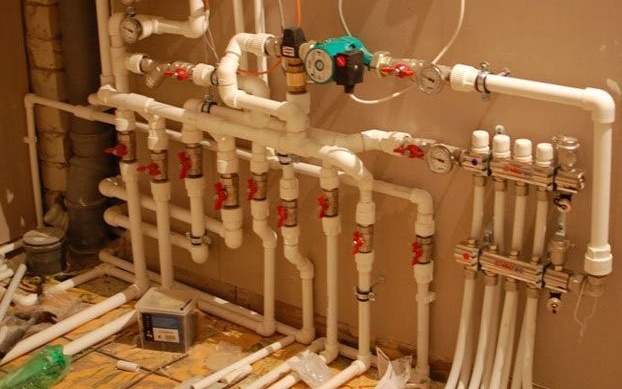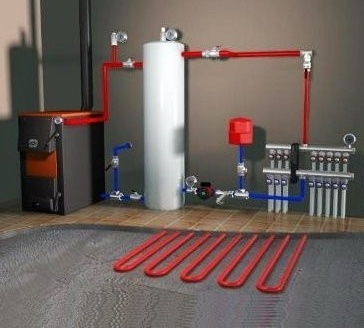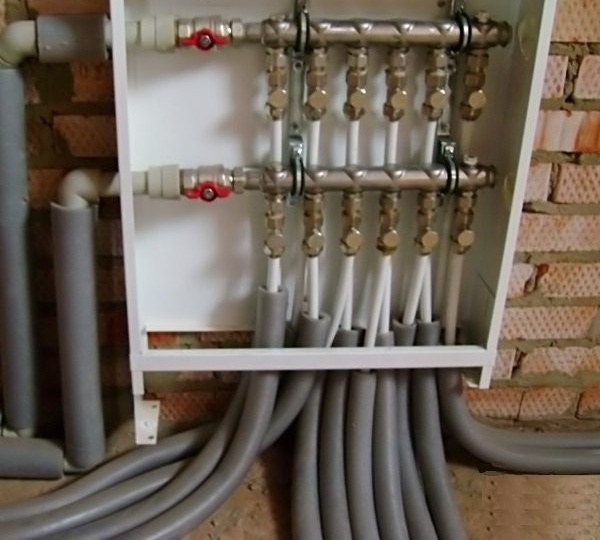Radial distribution of the heating system: design principles and analysis of all the pros and cons
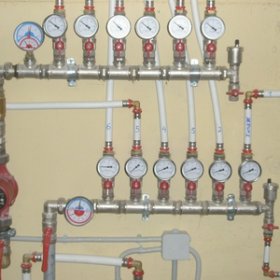
Comfortable life in a warm country house depends not only on the boiler. Everything matters here: from pipe diameters to heating wiring. The tee system goes into oblivion: too little efficiency and "slowness." It is impossible to set the temperature in the premises at different levels, or to make repairs in the winter without evicting households. And the radiant heating system, on the contrary, is increasingly becoming the choice of the owners. Previously, it required large material costs, which is why it was rare.
How is this system different from a tee?
Radial wiring of the heating system involves the parallel connection of heating devices to the distribution manifold. Two pipes go separately from each node to the radiator: feed and return. The collector itself is a large-sized equipment, so in most cases it is preferred to place it in a special cabinet.
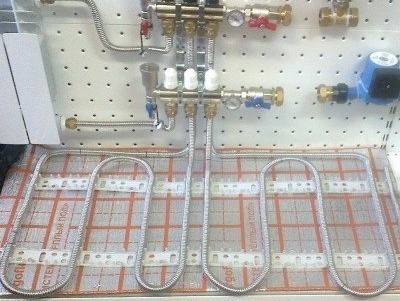
The collector of the radiation system allows you to turn off each radiator or hinge separately. At the same time, the remaining branches work as usual, so tenants may not leave the house in the winter during the repair, it is also warm in it
The usual tee wiring requires, of course, a smaller footage, but at the same time, connections and fittings will need incomparably more. And this installation complicates, and increases the likelihood of breakage, from the same pressure surges or assembly errors.
With collector wiring, pipe consumption increases, but all connections remain available, so repairs can be done much faster. Each individual “beam” of the system is easily turned off without affecting the rest of the premises.
The radiant heating system of a two-story house can be based on both forced and natural circulation.
One of the main advantages of such a system is the ability to hide all the pipes. With tee wiring, it is simply impossible to make a hidden gasket, otherwise you will have to break walls or the floor during repairs.
See also a comparative overview of tee and collector heating systems:https://aquatech.tomathouse.com/en/santehnika/razvodka/sxema-razvodki-vodoprovoda.html.
Radiant forced circulation heating system
Five to ten years ago, such a system was affordable for only one in twenty homeowners. But now the prices for automation and heating equipment have decreased, making it more affordable.
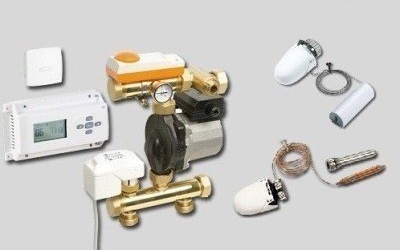
The efficiency of heating radial distribution, in particular, with forced circulation systems, makes it possible to install a whole range of shutoff and control valves: air vents, temperature sensors, shut-off valves and thermal heads. All this makes it possible to save on heating even during the absence of the owners of the house
Main advantage forced circulation - artificial run of coolant through pipes and radiators. The pump can be installed both on the return line and on the supply.Such a system is not demanding on the geometry of the premises of the house, the length of the branches and the hydraulic resistance of the pipeline.
Radiant heating system with natural circulation
Natural (gravity) circulation of the heat carrier in the heating system involves the use of large diameter pipes and the installation of an expansion tank. This is not always convenient: a compensator for expansion of the coolant should be installed at the highest point of the house. At the same time, the radial distribution of heating with natural circulation allows you to save on additional equipment. Expensive pumps, temperature sensors, air vents - such a system does not require any of this.
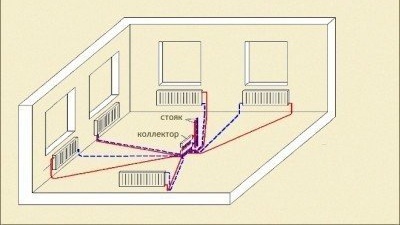
Even at the design stage of the house, you need to decide whether circulation will be carried out in the system in a natural way or through pumping equipment. The first option is most suitable for summer houses or non-electrified houses, while the second, being more effective, has been widely used in the last ten years.
If the house is used as a summer residence or it is unfinished, not connected to the mains, then the best solution would be the natural circulation of the coolant in the system. Even without powerful pumps and automation, the rooms will be quite warm.
Analysis of all the pros and cons - to do or not to do?
When preparing an estimate and a heating wiring project, you need to weigh all the pros and cons of the radiation system. Its flaws are heard by everyone who is at least a little interested in individual construction:
- material consumption and, consequently, higher cost compared to tee wiring;
- the need to allocate space for the manifold block or a special cabinet.
Some principles of this type of wiring can be seen in the video:
And, as for the pluses, everyone knows what they are, but it’s difficult to specifically name them. Most often you can hear that the beam wiring is simply better and that's it. But it gives a lot of opportunities and advantages:
- simplicity of design and installation: pipes of the same diameter are used from the distribution manifold to radiators;
- with hidden pipe laying in the floor there are no connections;
- ease of installation due to the small number of connecting elements;
- hydraulic stability of the radiation system. This is especially important for those who use plumbing, mainly imported, whose working pressure is three atmospheres;
- the system is balanced, all rooms warm evenly;
- a damaged pipe fragment can be replaced without opening the floor;
- shutdown of only one radiator with supply and return lines (the remaining radiators work at the same time);
- the ability to adjust the temperature in each individual room mechanically or electronically;
- the ability to install control and shutoff valves (flow and temperature sensors, air vents, shut-off valves and thermal heads).
Read about the methods of adjusting the temperature in heating systems in our next article:https://aquatech.tomathouse.com/en/otoplenie/radiatory/regulirovka-temperatury.html.
The beam system is effective not only because of its flexibility, but also due to the possibility of installing modern automation. Using the external control panel and the data exchange contact, you can automatically change the temperature in accordance with weather conditions. And the sensors in the rooms allow you to set individual parameters that are convenient for residents.
